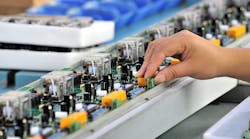Look for Discrete Chip Lead Times to Shrink and Prices to Decline in 2019
Semiconductor buyers can expect falling prices and shorter lead times for transistors, diodes, and other discrete semiconductors next year as supply increases and demand weakens.
Over the past 12 months, discrete semiconductor prices have increased and lead times have stretched to 30 or more weeks for some chips. However, suppliers have added capacity and lead times are starting to shorten for some parts. “They are not yet in the 12-week range, which is normal for most discretes,” said Rob Lineback, senior market research analyst for IC Insights, based in Scottsdale, Ariz. However, supply conditions are now starting to change and lead times will scale back, especially in 2019, he said.
“From a purchasing point of view, supply conditions are swinging back to favor buyers,” Lineback explained. He predicted lead times will eventually “drift back to the normal 10 to 12 weeks, stay there for a little while, and then probably…will get shorter as we get closer to 2020.”
Shorter lead times for discretes would be welcome news to semiconductor buyers, who continue to be challenged with tight supply conditions for some discretes. Discrete chips include small signal transistors, power transistors, diodes, rectifiers, and thyristors.
“The delivery situation for discretes is still constrained,” and most suppliers increased prices this year, said Stephanie Martin, senior vice president global supply for electronics manufacturing services provider Vexos, based in Markham, Ont., Canada. Most lead times for discretes from Infineon, STMicroelectronics, and ON Semiconductor are beyond 38 weeks, she said.
In fact, there have been shortages of some discretes over the past 12 months. Many buyers have not been able to purchase all the parts they need from chipmakers or their authorized distributors and have had to source parts from brokers and independent distributors.
Tags increase
Because of robust demand and shortages, average prices from manufacturers and authorized distributors have increased 8% in 2018 and even more on the open market.
With strong demand and rising prices, the global discretes market will end 2018 growing about 12% to a “record high $27.6 billion from the current peak of $24.6 billion set in 2017,” said Lineback. Sales growth will be slower in 2019 as revenue rises 5% to $29 billion and then remain flat in 2020 because of slower unit demand, he said.
The good news for buyers is that because capacity has been added, prices will decline by about 2% in 2019, according to Lineback.
One reason slower growth for discretes is expected is because a general economic slowdown is forecast for the U.S. and other regions. “A lot of folks have been talking about a global recession by 2020,” said Lineback. The economic slowdown will start in 2019 and will impact the overall semiconductor market, including discretes.
“The global economy really does drive the semiconductor industry much more than in the past,” said Lineback. “Capacity used to drive the industry,” he said. If there is too much capacity, prices would fall and sales revenue decline. Chipmakers would then cut back on capacity, leading to part shortages, higher prices and strong revenue increases.
“But the global economy is the big driver now,” he noted. When the global economy slows, so does the semiconductor industry.
Opto Prices to Fall
Besides discretes, buyers can also expect ample supply and falling prices for optoelectronic products, including LEDs. In 2018, average optoelectronic component tags will decline 6% and then fall another 3% in 2019, according to IC Insights. Despite falling prices, the overall optoelectronics market will increase 11% to a record $40.9 billion 2018 and then grow another 10.5% to $45.2 billion, the researcher said. Unit shipments are expected to increase 18% in 2018 and 14% in 2019.
Optoelectronics include LEDs, character displays, lamps, optocouplers, lasers, and light sensors.
Lineback said one reason for strong revenue growth in optoelectronics is very high demand for light sensors, which are widely used in automatic controls for displays and smartphones, heartrate monitoring equipment, scanning systems, and other equipment.









